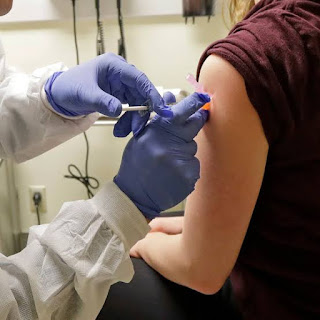Moderna's COVID-19 Vaccine Shows Promise in First Published Results - by Life Science
After receiving two doses of the vaccine, all 45 participants developed so-called neutralizing antibodies against the virus.
An experimental COVID-19 vaccine from the biotech company Moderna showed promising results in an early trial of 45 participants, according to the first trial data from the company to be published in a peer-reviewed journal.
After receiving two doses of the vaccine, called mRNA-1273, all participants developed so-called neutralizing antibodies, which can block the new coronavirus from infecting cells. The levels of these antibodies in participants' blood were above the average levels seen in recovered COVID-19 patients, according to the study, published Tuesday (July 14) in The New England Journal of Medicine.
The findings from this early Phase 1 trial back up results that the company released in May, which were not published in a peer-reviewed journal at the time.
The vaccine, which is being developed in partnership with the U.S. National Institutes of Health, was the first to be tested in humans in the United States. The company has already started a more advanced trial of the vaccine, known as a Phase 2 trial, and plans to start a large Phase 3 trial with 30,000 participants on July 27, according to The New York Times.
Advert :

The current study involved healthy participants ages 18 to 55 who were vaccinated at sites in Seattle and Atlanta. Participants were divided into three groups (with 15 participants each) and were given a low (25 micrograms or µg), middle (100 µg) or high dose (250 µg) of the shot.
Advert :
The vaccine appeared safe and generally well-tolerated by participants, although more than half of participants experienced some side effects, including fatigue, chills, headache, muscle aches and pain at the injection site. (To put this in perspective, many of these side effects are also seen with the annual flu shot.) Some participants in the middle and high dose groups experienced a fever after the second injection. (Fever can also be a side effect of the flu shot, albeit a rare one.)
One of the participants in the high dose group developed a "severe" fever of 103 degrees Fahrenheit (39.4 degrees Celsius). This participant also experienced nausea, lightheadedness and an episode of fainting, but felt better after a day and a half, according to The Los Angeles Times.
Data on the side effects and immune response seen in this study helped researchers refine the vaccine dose to be used in the Phase 2 and Phase 3 trials. The Phase 2 trial will examine doses of 50 µg to 100 µg, and the Phase 3 trial is expected to examine the 100-µg dose, the authors said.
Advert :
The Phase 3 study is expected to be completed by October, but more time may be needed to show that the vaccine is safe and effective, according to The New York Times. Ideally, researchers want to show that people who received the vaccine were less likely to develop COVID-19, and the fastest way to do this may be to test the vaccine in COVID-19 "hot spots," the Times reported.





Comments
Post a Comment
Enter your comments, enquiries, or feedbacks in this box